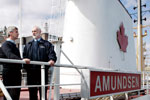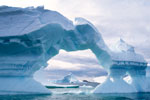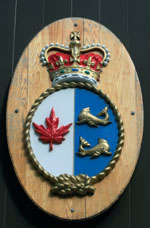Flagship on global warming
Canadian Coast Guard icebreaker Amundsen is exploring how the planet’s warming climate is changing the fragile Arctic and its impact on the sustainability of life on Earth.
DATE 2023-11-28 AUTHOR Marian ScottTourists amble past the gourmet restaurants and boutiques lining Québec City’s waterfront, enjoying the brilliant spring sunshine. But on board Canadian Coast Guard icebreaker Amundsen, moored in the St. Lawrence River, there is no time to savour the delights of Canada’s most historic city.
Paintbrush-wielding crewmembers are busy sprucing up the 98- metre scientific research vessel from stem to stern. On July 26, the Amundsen – Canada’s only dedicated research icebreaker – will depart on a 7,500-kilometre journey to the Beaufort Sea in the Canadian Arctic. Researchers will spend the next 15 months studying how climate change is affecting one of the coldest regions on Earth.
“This is the flagship for Canada’s research on global warming,” says Jacques Mondy, Superintendent of Marine Engineering for the Québec region of the Canadian Coast Guard, as he leads Here magazine on a tour of the 8,000-tonne ship, which accommodates up to 43 scientists and 40 crew at one time.
Floating laboratory
 In all, 200 scientists from eight countries – T Canada, the United States, Russia, Japan, Norway, Denmark, France and Spain – will take turns living and working aboard the floating laboratory, named after Roald Amundsen, the Norwegian explorer who conquered the Northwest Passage in 1906.
In all, 200 scientists from eight countries – T Canada, the United States, Russia, Japan, Norway, Denmark, France and Spain – will take turns living and working aboard the floating laboratory, named after Roald Amundsen, the Norwegian explorer who conquered the Northwest Passage in 1906.
Like all Canadian Coast Guard vessels, the Amundsen is equipped with products from Alfa Laval that increase efficiency and help protect the environment, from Moatti lube oil full-flow filters to centrifuges for oil purification.
With a USD 36 million budget from different funding sources, the Amundsen’s 15-month Arctic foray is Canada’s most significant contribution to International Polar Year. Launched on March 1 in Paris, the international event is generating the most comprehensive body of research ever conducted into the Arctic and Antarctic. Over the next two years, ending in March 2009, more than 50,000 scientists worldwide will study how global warming is affecting polar regions and gauge the future impact of those changes on the rest of the planet. In all, 63 nations have earmarked USD 1.5 billion for 228 studies during the two-year event, the first International Polar Year since 1957–58.
Canada is devoting USD 135 million to polar research over the next two years. The Amundsen’s key role in this research effort is the brainchild of Université Laval oceanographer Louis Fortier, Scientific Director of Arctic Net, a network of centres of excellence in Arctic research at 23 Canadian universities.
Magnificent adventure
“Professor Fortier is the locomotive of this magnificent adventure,” says Mondy. Built in 1979, the Amundsen was formerly known as the Sir John Franklin and based in St. John’s, Newfoundland. In 1998 the Canadian Coast Guard put the Franklin up for sale to cut costs. Fortier approached the Canadian government with a proposal to turn the icebreaker into a research vessel, to be shared by the Coast Guard and Arctic researchers. In 2002, the Canadian Foundation for Innovation approved the project and invested USD 27 million to transform the Franklin into a stateof- the-art research vessel.
The ship’s new name is better suited to her innovative role in Arctic research than her former moniker commemorating the ill-fated Franklin expedition, Mondy notes. Sir John Franklin set out from England in 1845 with two well-equipped ships to explore the last uncharted parts of the Northwest Passage and perished with his entire crew of 128. “When you choose the name of a person for a scientific mission, you want that person to be a model,” Mondy says. “Amundsen was the most spectacular of all the Arctic explorers. That’s why we chose his name, as someone renowned for his success and the quality of his work.”
Remote-operated submarine
The Amundsen is equipped with 12 laboratories, freezers to preserve samples at -80°C, sophisticated sounding equipment and a cameraequipped, remote-operated submarine that can descend to 1,000 metres. A “moon pool” – a chamber in the hull open to the sea below – allows researchers to lower scientific instruments and take ocean samples.
Alfa Laval’s Moatti filters, which filter oil for the Amundsen’s diesel-electric engines, have improved environmental performance. Freshwater generators from Alfa Laval provide a continuous supply of water.
Under a sharing agreement between the Coast Guard and Arctic Net, the Amundsen spends each winter clearing ice in the St. Lawrence River and each summer plying the Arctic waters as a research vessel. But 2007–08 will be different, since the icebreaker will winter in the Arctic instead of returning to the St. Lawrence. Researchers aboard the ship will conduct a wide range of studies, from a health survey of Inuit communities to chemical analysis of Arctic sea ice.
Arctic temperatures rising
The Arctic is particularly vulnerable to climate change, Fortier explains. That’s because ice and snow cool the climate by reflecting the Sun’s energy back to space, so as the ice cover shrinks, warming is hastened. Average temperatures in the far north are rising twice as fast as elsewhere and the summer polar ice cap has shrunk by more than 25 per cent since 1979. If the trend continues, Fortier warns, summers in the Arctic could become ice-free by mid-century. While that could open formerly impenetrable waterways to shipping, the impact on northern peoples and wildlife will be catastrophic. The effects will have far-reaching impacts on the entire planet, as melting glaciers raise sea levels to cause flooding and as melting of the polar ice cap accelerates climate change.
 David Barber, who holds the Canada Research Chair in Arctic System Science at the University of Manitoba, will head the largest scientific endeavour aboard the Amundsen, the nine-month Circumpolar Flaw Lead System study. It will focus on the open waters along Arctic coastlines that separate the stationary ice that lines land masses from mobile sea ice. These open waters, or flaw leads – which vary in size from less than one kilometre to several hundred kilometres – provide a model to help scientists understand how global warming will affect the far north, Fortier explains. “As the planet warms, the flaw lead tends to increase,” he says. “It represents the Arctic Ocean the way it will look in 50 years.”
David Barber, who holds the Canada Research Chair in Arctic System Science at the University of Manitoba, will head the largest scientific endeavour aboard the Amundsen, the nine-month Circumpolar Flaw Lead System study. It will focus on the open waters along Arctic coastlines that separate the stationary ice that lines land masses from mobile sea ice. These open waters, or flaw leads – which vary in size from less than one kilometre to several hundred kilometres – provide a model to help scientists understand how global warming will affect the far north, Fortier explains. “As the planet warms, the flaw lead tends to increase,” he says. “It represents the Arctic Ocean the way it will look in 50 years.”
Point of pride
The Amundsen’s role at the forefront of global warming research is a point of pride for Mondy, 62, a 31-year veteran of the Canadian Coast Guard who graduated from Québec City’s Institut maritime du Québec in 1964. “I am a spoiled man,” he says. “I adore my work.” On his office wall is a poster of the Château de Biron in his native Périgord region of France, where Mondy still has family ties.
As Coast Guard Marine Engineering Supervisor for the Québec region, Mondy is responsible for the repair and maintenance of 19 ships, two hovercraft and 230 small craft. Scientific research is just one of five mandates fulfilled by the Canadian Coast Guard, whose core fleet totals 106 ships. Its primary responsibilities are icebreaking, marine traffic and communications, search and rescue and fisheries enforcement. Unlike its American counterpart, the Canadian Coast Guard is not a branch of the armed forces and its vessels are unarmed. However, its vessels sometimes transport officers of the Royal Canadian Mounted Police or Canada Border Services Agency.
Coast Guard icebreakers keep navigation channels in the St. Lawrence River open during the winter months to prevent flooding in Montréal, 250 kilometres upriver. Mondy notes the St. Lawrence froze as late as January 10 this year, about three weeks later than average. However, the river became ice-free at the normal date, at the end of March.
Mondy’s multiple responsibilities mean he will not be aboard when the Amundsen weighs anchor for its Arctic voyage. Still, he can identify with a poster on the ship inscribed by a recent guest, Canadian explorer Bernard Voyer, who has trekked to both poles and climbed Mount Everest. Voyer writes: “To live our passions and challenges is to experience freedom.” Roald Amundsen himself would surely agree.
Flagship: Proud Partners
“ Alfa Laval’s relationship with the Canadian Coast Guard has been going strong for more than 30 years. “
“The material from Alfa Laval is the most robust, simplest to operate and extremely efficient,” says Jacques Mondy, Superintendent of Marine Engineering for the Québec region of the Canadian Coast Guard The Amundsen and other Canadian Coast Guard icebreakers use three kinds of equipment from Alfa Laval:
Moatti full-flow lube oil filters have reduced maintenance costs and pollution. The Moatti filters require cleaning only after 7,500 hours of operation, in contrast to the previous filters, which required cleaning after just 20 hours. That has reduced manpower dedicated to maintaining the engine filters to one person from two. Crew members use water to clean the Moatti filters instead of the chemicals used to clean the old filters, so there is no more toxic residue.
Centrifugal separators eliminate sediment and impurities to prolong the life of engine and lubricating oils. The Amundsen’s centrifuges are 25 years old and still operating perfectly! Their easy-to-use design makes it easy to train the crew, which changes every 28 days on Canadian Coast Guard ships.
Freshwater generators produce the 32 tonnes of fresh water the Amundsen requires daily. Each of its two Alfa Laval freshwater generators, installed in 2003, is capable of producing 20 tonnes of water per day. “We have used different water desalination systems but the operating cost was high and they required a lot of maintenance,” Mondy says.
Bob Keating, Manager of Marine and Diesel for Alfa Laval in Canada, says the company enjoys a terrific relationship with the Canadian Coast Guard. “It is always a pleasure to work with these highly-skilled professionals. They want quality equipment and they know how to work with it.”

